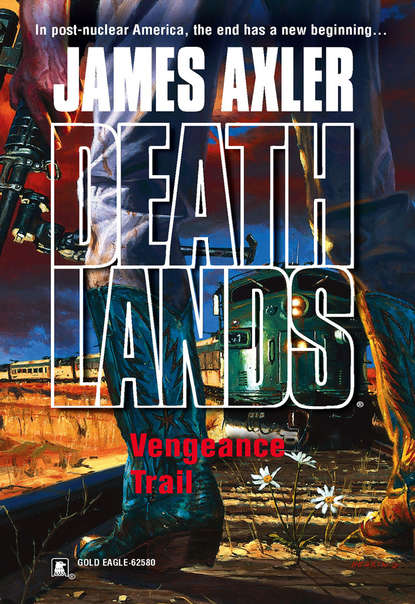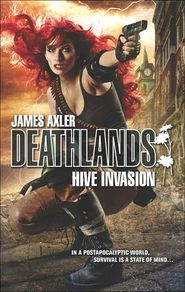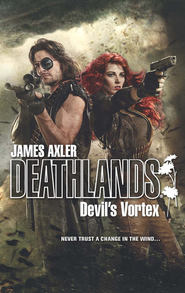По всем вопросам обращайтесь на: info@litportal.ru
(©) 2003-2024.
✖
Vengeance Trail
Автор
Год написания книги
2019
Настройки чтения
Размер шрифта
Высота строк
Поля
ONE OF IRONHEAD JOHNSON’S mountain men fired the opening round, the one that chilled Moredock, from a scoped and heavy barreled Remington 700. He lay on his belly on a low hogsback five hundred yards south of the train, and used his possibles bag for a rest. Johnson’s men were probably the most formidable fighters, man for man, of all the coldheart army. Johnson himself had disposed of the three-man observation post dug in on the rise, using his trademark foot-and-a-half-long, double-edged Arkansas toothpick.
At this point the track ran east and west straight as a laser beam. A road, its pavement still largely intact, but serving now mainly as a super-durable bed for layers of drifted sun-baked mud, ran along the south side of the embankment. The compound where the slave-laborers were sheltered under canvas was south of the road and the giant, gleaming, fusion-powered engine, to allow trucks to trundle back and forth carrying supplies from freight cars well back in the train.
From the east appeared a small fleet of dune buggies and wags, filled with young men waving longblasters. These were the Wild Boys, a local crew of coldhearts commanded by Wild Wess Wilhelm.
An arroyo cut from six to ten feet deep, with steep walls that had fallen in places because of rare but intensely savage downpours, ran at a diagonal south of the road, passing about two hundred yards from the slave stockade. From it now erupted most of the rest of Chato’s misfit army: El Gancho’s pistoleros from northern Mex, mounted on horseback.
Hogan’s contingent of fifteen outlaw bikers on lowslung, snarling sleds. No dirt bikes, to say the least, the heavy motorcycles had been wheeled by hand along the soft sand of the arroyo bottom, to a place where a cave-in provided a natural ramp. Small in numbers, his band was unsurpassed in cruelty.
Most of Red Wolf’s band of Plains Indian cutthroats had ridden off in a huff after their leader’s demise. However, staunch individualists that they were, seven or eight had remained and now joined the charge on their painted ponies.
And finally, twenty or so random chillers, who had drifted into the army at large, but not yet into any kind of affinity group. These loose ends had been sent off with the main body under the command of Bug Eye Mueller, who was suspected by many of being a mutie because of his unfortunately protuberant eyeballs, but who was so mean nobody ever so much as mentioned it.
The throat and purse-slitters of El Abogado, snoop and poop specialists all, formed no part of the attack. They had their own assignment.
And finally, Chato himself sat nervously on his paint pony atop a hill well to the south, leading from the rear where he could keep a good eye on the proceedings as was appropriate to a coldheart warlord of his stature. Or so he’d told his faithful followers.
No, it wasn’t a good plan. But it was shitloads better than admitting he’d drawn a blank, and having his coldheart followers decide to see what his insides looked like, preparatory to picking out a new leader.
“DOWN! Everybody get down!”
J.B. had already followed his own advice, and was speed-crawling toward the fallen corporal on leather-jacket clad elbows. Mildred, as seasoned a combat veteran as any, had also hit the dirt before the shot finished echoing.
Pretty much everybody else, guards and captives alike, was standing around, completely clueless to what was going down—even as two more guards were nailed by snipers.
However, not even the slowest or most stunned of wits could long mistake about 150 coldhearts, armed to the eyeballs and howling for blood, charging at them on horses, outlandishly modified motorcycles, and their own hind legs. The soldiers on guard, well-trained by Deathlands standards—meaning they had some—unslung their blasters, took up firing positions and started shooting.
So did the crews manning the heavy weapons mounted in casements and pop-up turrets on the armored wags of the train. MAGOG was like a weird monster millipede: its first ten or so segments were armor-plated, as were the very last two wags, a second engine and a gun-bristling caboose. Other armored wags were spaced at intervals among the more conventional freight and passenger wags. As he pulled Moredocks’s Beretta from its flap-covered field holster, the Armorer heard the snarl of 5.56 mm machine guns, the throaty growl of 7.62 mm M-60s and, sweetest of all, the Thor’s-hammer pounding of the .50-caliber Browning M-2. He could feel the muzzle-blasts, beating on the back of his jacket and stinging the exposed back of his neck.
Looking up, he saw the nearest attackers were still 150 yards off. He rifled the stiff for spare mags.
AS PLANS WENT, Chato’s wasn’t really all that bad. Given the resources, it was about as good as might have been come up with.
Of course, it was doomed. He’d been right about that.
For one thing, MAGOG carried more dedicated fighters than Chato had, not to mention another hundred or so support types, cooks and clerks, who could fire a CAR-15 or submachine gun out windows and firing ports about as well as anybody. And neither Chato nor any of his followers had the remotest conception of how much sheer firepower MAGOG mounted.
Two could play the sharpshooting game, for instance. There were four dedicated antisniper turrets, each containing a shooter behind a Barrett Light Fifty sniper rifle and a separate spotter, each using mounted optics far superior to what Ironhead Johnson and his boys had. As Johnson realized, peering at the train through ancient but excellent Zeiss binocs for the few short heartbeats before his head turned into pink mist. Not even iron was proof against a 709-grain jacketed slug traveling about four times the speed of sound, it turned out.
Nor had the coldhearts grasped the fact the General had dozens of machine guns of various calibers at his command. And here came the first serious hitch in the plan: however reluctant the rail wag soldiers may have been about firing up their own buddies, much less the laborers, many of their machine guns were mounted on top of the train, where they could fire right over the heads of guards and prisoners alike.
Then there were the automatic grenade launchers, and the 82 mm mortars that quickly began to chug and cause big gouts of earth and assorted body parts to spout up out of the desert.
And Wild Wess Wilhelm received the surprise of his life—and death, as it happened—when a rack popped out the top of the train’s engine. He didn’t see it, because it was infrared and invisible to the unaided eye, the laser-designation spot painted right on the pearly third snap-button of his shirt as he rode standing up behind the roll bar of his Baja buggy. He did see the puff of white smoke as the Hellfire antitank guided missile came off the rack, however.
He had time to shout a hysterical command to his driver, who was already yanking the wheel hard right in a turn, which would have rolled the buggy and spilled them all out to their deaths or at least painful and crippling injury. The huge missile, however, struck the lower edge of the roll bar before the tires had even broken loose in a skid. A jet of copper from the shaped-charge warhead, so incandescent hot it was almost plasma, simply vaporized young Wilhelm’s midsection and right shoulder and about half the head of the driver. Then the speeding wag began to roll broadside, but now as a ball of fire, trailing blazing fuel and a giant caterpillar of black smoke. Another buggy lost it, veered from the road and took off end for end trying to avoid the blazing wreck, scattering its occupants in every direction. And then the machine guns began raking the wags that were attacking along the road.
The second serious problem with Chato’s plan now appeared: the expectation that the slaves would either flee in panic, disrupting the defenders, or better still actually begin to fight with their guards. But few of the captives had grown up in what anybody would call sheltered circumstances; life really was tough all over. As for regarding the attackers as liberators, trust of scruffy wild-acting guys with blasters wasn’t deeply engrained in the contemporary psyche. After all, however badly the soldiers had treated and were treating their slaves, it was the coldhearts who were shooting at them.
Of course, there are always a few who don’t get the message. Ten or fifteen captives did try bolting and got ripped to wet red rags, some with fingertips scraped bloody from trying to claw their way up the steep railway embankment. Most of the slaves had too much sense to try to outrun the bullets cracking past their ears, and instead just dropped flat against the ground.
Doomed, but not entirely futile. The attackers boiling out of the arroyo had appeared suddenly and were fairly close at hand. A lot of the slower ones got minced and mulched by the horizontal lead storm. Others went to their bellies and opened vigorous, if not particularly accurate, fire.
The rest quickly got under the heavy weapons’ arcs of fire, so close the blasters mounted atop the train couldn’t depress any farther to track them. It was one of the few true cracks in mighty MAGOG’s defenses. And eighty or ninety armed and angry coldhearts were pouring through it.
Crawling with less alacrity than J.B., Mildred had reached the body of a soldier downed in the first ragged volley of sniper fire. With MAGOG’s blasters thundering overhead and shutting out the screams of the injured, she pulled free his M-16. She assumed a classic prone firing position, her body at forty-five degrees to the target, behind the stiff, using him as cover and a rest. She was a devoted pistol shooter—an Olympic competitor, in fact—but she could shoot a longblaster with a high degree of accuracy.
Clicking the selector to single shot, she began to take out targets. She aimed at the coldhearts she deemed most threatening—the ones who seemed to be shooting most effectively themselves. At almost every shot, a bandit dropped.
J.B. had taken cover behind the late Corporal Moredock and was firing aimed singles from the Beretta with a two-handed grip. Thirty yards away from his friends, Jak had scooped up two M-16s from downed guards, one gazing sightlessly at the sky, the other rolling around shrieking and clutching a shattered shin, out of the fight. Not a great marksman, he was firing both at once.
From the hip.
Normally there was no craftier fighter than the albino youth from the bayou. Not now. All the fury that had been building within him since he had watched his friend and revered leader fall into the Grand Canyon the day before boiled up within him and out his mouth in an unending scream of fury, and out the muzzles of the M-16s in uninterrupted streams of lead.
One of Red Wolf’s hawk-faced Plains chillers, riding a buckskin, charged Jak with a feathered lance. Jak stood his ground and blasted the mount with both rifles. The horse screamed in mortal agony as it reared, fountaining blood from a dozen holes, and fell over backward, trapping its rider’s leg and crushing his pelvis and the lowest three vertebrae of his spine. As he howled in his own death agony, a second Plains rider charged, raising a war club with a cast-iron ball for a head. He was already too close to take down with the M-16s’ lightweight bullets.
Having spent some time on his own ranch in New Mexico, Jak knew a thing or two about horses. Specifically, that a horse wouldn’t run over anything it thought could trip it. He knelt and ducked his head, making an X of the two longblasters before his face. The horse, disregarding its rider’s intentions, launched himself and jumped clean over the white-haired boy, who was dropping and rolling to his right even as the great shadow passed over him. From his back he emptied both magazines into the bare back of the rider. Uninjured, the horse ran on, eyes rolling, foam flecks flying from its nostrils.
A biker roared toward J.B., firing an Uzi over his T-bar handlebars. He didn’t hit anything, the way his ride was jouncing all over the place. More concerned with the imprint the front tire would make on his forehead, J.B. recoiled by reflex to a sitting position, firing the Beretta as fast as it would cycle. He wasn’t just spraying and praying. The biker went over the back of his postage-stamp-sized seat with the Uzi still blazing.
For another heart-stopping instant the heavy bike charged on. J.B.’s eyes got wide behind his glasses and he cocked himself for a wild spring to the side. The outlaw sled wobbled, toppled and slid toward him broadside, raising a big bow-wave of khaki earth and dried weeds. J.B. held his hands up before his face.
The bike stopped with its tires spinning inches short of Moredock’s corpse.
J.B. heard a familiar voice cry out. Reflexively he looked toward it—to see Mildred, in a perfect kneeling position, aiming her M-16 right between his eyes.
Chapter Six
Leading four of his bros, Hogan rode his bike back along the road toward the rear of the train. He realized the machine guns couldn’t reach them here. Laughing and shouting in triumph, he was firing away into the passenger cars, their metal skins too thin to stop the bullets from his Ruger Mini-14. He couldn’t tell if he was actually hitting anybody, but it didn’t matter. He was laying some hurt on the monster. It wasn’t invincible after all.
But neither was MAGOG helpless.
The bikers came to an armored wag. Fearing shooters firing out blasters, Hogan stopped busting caps himself, leaned low between his high curved bars and accelerated rapidly.
As a result, he was past the killing zone when a strip of four Claymore mines mounted along the side of the armored car were initiated remotely from within. They went off with a rippling, ear-busting crack that spewed the roadway with about ten thousand steel marbles. The four riders behind Hogan simply disintegrated in shreds of flesh and steel, blood and gasoline, that all instantly began cooking in a hell-stew on the road as the gasoline lit off.
That was enough for Hogan. He was braver than most, man or mutie, but he knew when his match had been met. He kept the throttle cranked and went rocketing along the rest of the train, past the armored wags at its tail, relying on speed and surprise to keep him untouched by the sprays of bullets and 40 mm grenades that hosed out after him, until he vanished safely through the smoke from two downed wags, all blazing away on the road barbecuing their occupants who hadn’t been lucky enough to bail, some of whom were still bitching about the fact with wild screams.
Of course, the bullets weren’t stopped by the smoke. And MAGOG’s gunners, who had a whole freight car full of them, didn’t stop shooting them blind. But as soon as he was well within the smokescreen—steering around the furnace wrecks by sheer road-weasel instinct—he cranked the bike ride and lit out cross-country, passing quickly between a low rise and getting clean away.
J.B.’S EYES WIDENED again as flame blossomed in four yellow petals from the flash suppressor of Mildred’s M-16. A vicious crack left his left ear hearing nothing but a loud ringing. Hot air stung his cheek like a red ant’s bite.
He turned. A squat man in a filthy grayish sweatshirt and baggy sweat pants loomed over him with a fire ax raised over his head in both hands. He had a weird bowl-shaped haircut and was looking cross-eyed at a small, neat blue hole right through the bridge of his nose. He collapsed at the tip of the Armorer’s boot, the back of his head missing.
J.B. blew out a long breath, then threw himself down behind Moredock again to take stock of the tactical situation.
Shots were still cracking in both directions. The heavy weapons still split the sky overhead. They mostly seemed to be working the far ridgeline, trying to hose off any snipers the Barrett gunners had missed. But nobody was charging.











